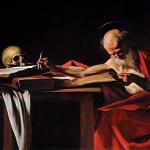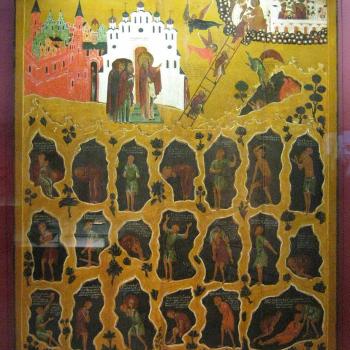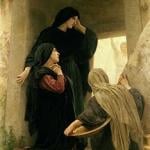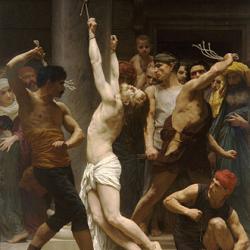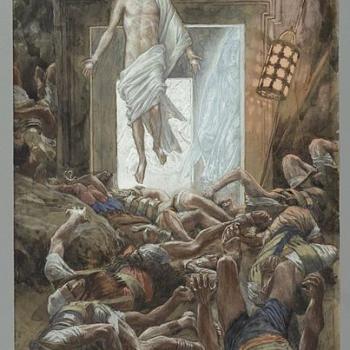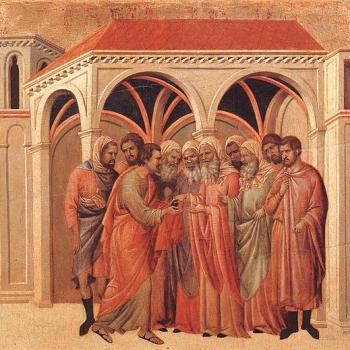Last Time on HORATS
This Time We Enter the decade that gave us Frankenstein and Silent Night.
Going into this decade…
Servant of God Pius VII was pope # 251.
March 14, 1800 – August 20, 1823 (23 years, 159 days)
James Madison (1751–1836) was President # 4.
March 4, 1809 – March 4, 1817
1811
- St. John Neumann (March 28, 1811 – January 5, 1860) is born.
- October 11,1811 – Inventor John Stevens‘ boat, the Juliana, begins operation as the first steam-powered ferry service, between New York City and Hoboken, New Jersey.
- October 30, 1811– Jane Austen publishes her first novel: Sense and Sensibility (“by a lady”) at her own expense in three volumes, priced at 15 shillings, in Thomas Egerton’s Military Library (Whitehall, London).
- Franz Xaver Wolfgang Mozart – Piano Concerto No. 1 in C major opus 14
1812
Downright Dencey is a 1927 children’s historical novel by Caroline Dale Snedeker. The novel, illustrated by Maginel Wright Barney, was first published in 1927 and was a Newbery Honor recipient in 1928. he story is set in Nantucket, Massachusetts shortly after the War of 1812, and deals with the unlikely friendship between a Quaker girl, Dencey Coffyn, and Jetsam, the adopted son of the town drunk.
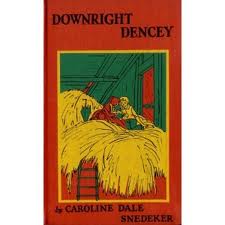
- January 2, 1812 Samuel Taylor Coleridge‘s lecture on Hamlet is given as part of a series of lectures on drama and Shakespeare; it has influenced Hamlet studies ever since.
- Martin Boehm (November 30, 1725 – March 23, 1812) was an American clergyman and pastor dies. See 1813 to understand more about him.
- April 30, 1812 – Louisiana is admitted as the 18th U.S. state.
- June 18, 1812– The War of 1812 between the United States, Canada and the United Kingdom begins with US declaration.
- Published Books-Johann David Wyss – The Swiss Family Robinson/ The Brothers Grimm – Grimm’s Fairy Tales, volume 1
- 1812 – The Mystery of Synesthesia The first agreed upon account of synesthesia comes from German physician Georg Tobias Ludwig Sachs, who reports on his colored vowels as part of his PhD dissertation (on his albinism), although its importance has only become apparent retrospectively.
- Sacagawea (May c. 1788 – December 20, 1812, or April 9, 1884) was a Lemhi Shoshone woman who, in her teens, helped the Lewis and Clark Expedition in achieving their chartered mission objectives by exploring the Louisiana Territory. Sacagawea traveled with the expedition thousands of miles from North Dakota to the Pacific Ocean, helping to establish cultural contacts with Native American people and contributing to the expedition’s knowledge of natural history in different regions.
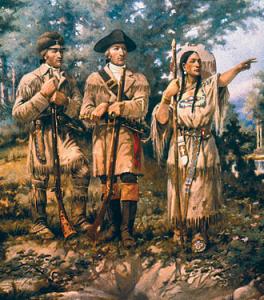
1813
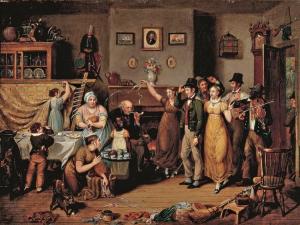
The Quilting Frolic John Lewis Krimmel (May 30, 1786 – July 15, 1821),
- January 28,1813 – Jane Austen‘s Pride and Prejudice is published anonymously in London.
- March 4, 1813 James Madison is sworn in for a second term as President of the United States.
- September 4,1813 – The name of Germany’s national card game, “Scat” (modern-day Skat), appears for the first time, in the gaming records of Hans Carl Leopold von der Gabelentz.
- October 2, 1813 – The Philomathean Society of the University of Pennsylvania is founded (the oldest continuously existing literary society in the United States).
- Philip William Otterbein (June 3, 1726 – November 17, 1813) died. He was an American clergyman who along with Martin Boehm founded the United Brethren in Christ, It is the first American denomination that was not transplanted from Europe.
- December 8 – Ludwig van Beethoven‘s Symphony No. 7, together with his Wellington’s Victory, are premiered in Vienna under the composer’s baton, in a benefit concert for Austrian and Bavarian soldiers wounded at the Battle of Hanau.
1814
- July 28–September 13 – English poet Percy Bysshe Shelley abandons his pregnant wife and runs away to France and Switzerland with the 16-year-old Mary Wollstonecraft Godwin, accompanied by her stepsister Jane Clairmont, also 16.
- August 7 1814– Pope Pius VII decrees the bull Sollicitudo omnium ecclesiarum, reestablishing the Society of Jesus (Jesuits) all over the world, after having approved their survival and existence in Russia.
- August 24, 1814 – Burning of Washington (War of 1812): The British burn the original Library of Congress, at this time housed in the United States Capitol in Washington, D.C.
- “The Star-Spangled Banner ” is the national anthem of the United States. The lyrics come from the “Defence of Fort M’Henry“, a poem written by American lawyer Francis Scott Key (August 1, 1779 – January 11, 1843) on September 14, 1814, after he witnessed the bombardment of Fort McHenry by the British Royal Navy during the Battle of Baltimore in the War of 1812. Key was inspired by the large U.S. flag, with 15 stars and 15 stripes, known as the Star-Spangled Banner, flying triumphantly above the fort after the battle.
1815

- February 18, 1815 – The War of 1812 between the United States and the United Kingdom (including Canada) officially ends, following ratification of the Treaty of Ghent (1814) in Washington, D.C.
- June 18, 1815 – Napoleonic Wars – Battle of Waterloo: Arthur Wellesley, 1st Duke of Wellington, Gebhard Leberecht von Blücher decisively and this time permanently defeat Napoleon.
- John Carroll (archbishop) (January 8, 1735 – December 3, 1815) prelate of the Roman Catholic Church, archbishop of Baltimore dies.
- St. John Bosco, SDB (August 16, 1815 –January 31, 1888) is born.
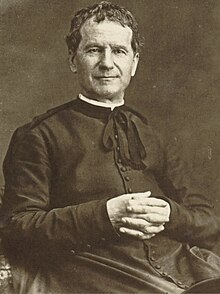
1816
- Saint Julie Billiart (July 12, 1751 –April 8, 1816) dies. She was a French Catholic nun, educator, and cofounder of the Sisters of Notre Dame de Namur.
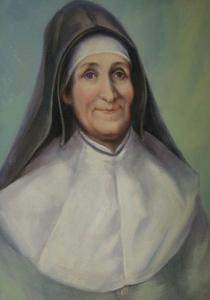
- July 1816– Lord Byron, Mary Wollstonecraft Godwin, Percy Bysshe Shelley and John Polidori, gathered at the Villa Diodati by Lake Geneva in a rainy Switzerland, tell each other tales. This gives rise to two classic Gothic narratives: Mary Shelley‘s Frankenstein, and Polidori’s The Vampyre.
- December 11, 1816 – Indiana is admitted as the 19th U.S. state.
- E. T. A. Hoffmann publishes Nussknacker und Mausekönig (The Nutcracker and the Mouse King, basis of ballet The Nutcracker)
Count Karlstein, or the Ride of the Demon Huntsman is the first children’s novel written by British author Philip Pullman. It was published in 1982. The story was originally written by Pullman to be performed as a school play at Bishop Kirk Middle School, Oxford, where Pullman was an English teacher. The novel is set in the fictional Swiss village of Karlstein in 1816.
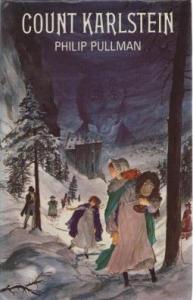
Can you hear the distant howling of hounds and the thunder of ghostly hooves? It’s All Souls’ Eve and Zamiel the Demon Huntsman has come to claim his prey! He’s headed straight for Castle Karlstein, where the evil count has hatched an evil plan; he’ll sacrifice his two young nieces to save himself. Can Lucy and Charlotte outwit their uncle and his oily henchmen to escape their dreadful fate? From the award-winning author of The Golden Compass and The Subtle Knife comes a spooky, funny thriller just right for those middle-grade readers looking for horror–and humor. – Amazon Description
1817

- Frederick Douglass (c. February 1817 or February 1818 – February 20, 1895) the escaped slave and popular writer and speaker is born.
- March 4,1817– James Monroe is sworn in as the fifth President of the United States.
- April 15, 1817 – The American School for the Deaf opens in Hartford, Connecticut.
- July 18 – Jane Austen, English novelist (born 1775) dies.
- December 7 – William Bligh (September 9, 1754 – December 7, 1817), dies. He is best known for the mutiny on HMS Bounty, which occurred in 1789 when the ship was under his command.
- December 10, 1817– Mississippi is admitted as the 20th U.S. state, formerly the Mississippi Territory.
1818
Picture This

News of the World
- January 3 (21:52 UTC) – Venus occults Jupiter. It is the last occultation of one planet by another before November 22, 2065.
- March 22 – Easter Sunday in Western Christianity falls on its earliest possible date. In Western Christianity, it will not occur on this date again until 2285.
- April 4 – The United States Congress adopts the flag of the United States as having thirteen red and white stripes, and one star for each state (twenty), with additional stars to be added whenever a new state is added to the Union.
- July 15 – U.S. President James Monroe convenes a cabinet meeting, to discuss whether General Andrew Jackson‘s unauthorized invasion and conquest of Spanish Florida should be disavowed by the White House. Secretary of State John Quincy Adams persuades the President that the action is justifiable, in stopping terror caused by the Seminole tribes.
- October 20 – A treaty between the U.S. and the United Kingdom establishes the boundary between the U.S. and British North America as the 49th parallel, from the Lake of the Woods to the Rocky Mountains, also creating the Northwest Angle.
- December 3 – Illinois is admitted as the 21st U.S. state.
Arrivals
- February 14 – Frederick Douglass (his day of birth was never established; he adopted this date), American abolitionist author, statesman (d. 1895)
- May 5 – Karl Marx, German political philosopher, co-author of The Communist Manifesto (d. 1883)
- Eliza Allen Starr (August 29, 1824 – September 8, 1901) was an American artist, art critic, teacher, and lecturer. She was known throughout the United States and Europe for her books about Catholic art.
Departures
Johann David Wyss, May 28, 1743 – January 11, 1818) was a Swiss author, best remembered for his book The Swiss Family Robinson (Der schweizerische Robinson) (1812). He was born and died in Bern. It is said that he was inspired by Daniel Defoe‘s Robinson Crusoe, but wanted to write a story from which his own children would learn, as the father in the story taught important lessons to his children.
Publications Hot of the Press
- January 1 – Mary Shelley‘s novel Frankenstein; or, the Modern Prometheus first appears anonymously in London. Its originality is praised by Walter Scott.
- Jane Austen December 16, 1775 – July 18, 1817) Persuasion is the last novel completed by Jane Austen. It was published on December 20, 1817, along with Northanger Abbey, six months after her death, although the title page is dated 1818.
- Thomas Love Peacock (anonymous) – Nightmare Abbey
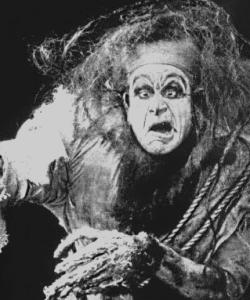
Sanctifying Time
- Saint Alphonsus Liguori appeared to Blessed Gaetano Errico, relaying the message that Gaetano is to build the church of Our Lady of Sorrows and found the Missionaries of the Sacred Hearts of Jesus and Mary
The Sound of Music and Other Cultural Milestones
- April 7 – Brooks Brothers, the oldest men’s clothier in the United States, opens its first store on the northeast corner of Catherine and Cherry Streets in New York City, where the later South Street Seaport stands.
- December 24 – The Christmas carol “Silent Night” (Stille Nacht), with words by the priest Josef Mohr, set to music by organist Franz Xaver Gruber, is first performed at St. Nikolaus Parish Church, in Oberndorf bei Salzburg, Austria.
- Ludwig van Beethoven – Piano Sonata in B flat “Hammerklavier” Op.106
“The Crimson Banner“, words and music by William Blacker
1819
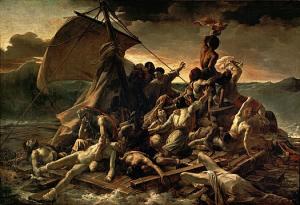
- Queen Victoria (May 24, 1819 – January 22, 1901) is born.
- June 23, 1819– Washington Irving begins publishing The Sketch Book of Geoffrey Crayon, Gent. in seven installments — the first including “Rip Van Winkle” and a later one including “The Legend of Sleepy Hollow” — simultaneously in New York and London (where Irving is living at this time).
- December 14, 1819 – Alabama is admitted as the 22nd U.S. state.
- December 20 – Walter Scott‘s popular Waverley Novel Ivanhoe is published anonymously in 3 volumes by Archibald Constable in Edinburgh, dated 1820. A chivalric romance set in 12th-century England, it represents a move away from Scott setting his fiction in Scotland.
Next Time on
HOARATS
The Mormon Saturday Evening Post Arrives in the 1820s
To Understand
What I love and How I Write About History
Hit the Link Above.
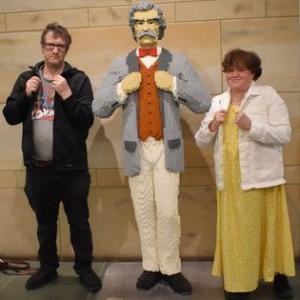
To understand about this particular series I’m writing about, please read
The Catholic Bard’s Guide To History Introduction
And to view a historical article click on



